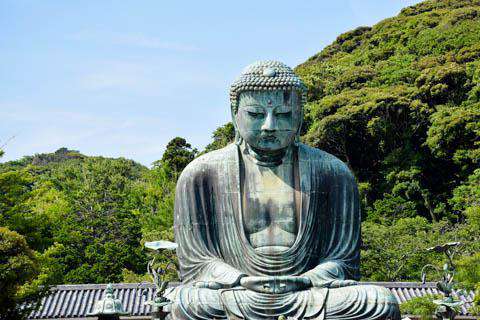Kamakura On a Budget
 The Buddha at Kamakura, Japan
The Buddha at Kamakura, Japan
Sights
The Great Buddha is one of the most popular attractions of the city. Standing in solid bronze outside the Kotokuin Temple in Western Kamakura, it remains the third largest Buddha in Japan at 13.35 meters. Probably cast around 1252, the statue was originally housed in a giant temple hall, but the building was washed away in a tsunami. This site gets very crowded on weekends and holidays. Hasedera and Zeniarai Benten Shrine are located nearby and also worth a visit.While the Amida Buddha is where many people flock, there are many stunning sights throughout the city, mostly in the form of shrines and temples. The largest Shinto shrine in the city is called Tsurugaoka Hachiman-gu Shrine and is located centrally. This shrine attracts the most visitors, reaching a million on New Year's Day to see the first sunrise of the year. Of all five of Kamakura's Zen temples, numbers one and two are located in the northern part of the city. Kenchoji is the oldest in the city, and one of the oldest in Japan, with a zen garden and a bell that has been designated a national treasure. Engakuji is the second, also with a bell, and a teahouse famous for its tokoroten-sweet cold noodles. The temples located in Eastern Kamakura are a little more off the beaten path, which can be worth avoiding the tourist crowds. Jomyoji, Sugimotodera, Shakado Kiritoshi, and Hokokuji are all located in this area and can be most easily reached by bus, as there will be a fair amount of climbing once you reach them.
Neighborhoods
Komachi-dori Street is probably the most well-known street in Kamakura, attracting visitors every day of the week. Lined with cafes, restaurants, and shops, Komachi-dori is always busy, especially with its proximity to the JR Kamakura Station and the main shrine of Kamakura, Tsurugaoka Hachimangu. Wandering along the avenue you might come across little boutiques, Japanese-style sweet shops, stores selling souvenirs, and others selling items unique to the ancient city. Some other oddities include incense stores, a historic restaurant for handmade soba noodles, internationally inspired cuisine, and even a kimono rental shop. "Komachi" literally means "small town," while "dori" means "street"-and the place really does have a small town atmosphere of its own.Activities
While visiting the shrines and temples is the most popular activity while in Kamakura, there are several hiking trails that can offer the peace and serenity of nature away from the busy crowds. The Daibutsu hiking course starts a few hundred meters down the road from the Kotokuin Temple. There are a few branching trails that lead to smaller shrines and temples off the regular tourist track.Being a seaside city, Kamakura is also a popular destination for beaches. Yuigahama beach is a great spot for sunbathing by day and watching fireworks by night, Inamuragasaki beach is famous for its sunsets, and Shichirigahama beach is a great place to go surfing and enjoy views of the famous Mount Fuji.
Food and Dining
In the vicinity of the train station, especially along Komachi-dori, there are plenty of restaurants, cafes, and street foods to indulge in. For a sweet treat, one of the local specialties is called murasaki-imo sofuto, or purple potato soft ice cream made from a kind of purple sweet potato found throughout Japan. Kamakura is also famous for its sembei, or rice crackers, which can also be found abundantly on Komachi Street. Other local favorites include bento box lunches, a type of fluffy rice omelet called omuraisu, biscuits, local beers and Japanese sake, sushi, seafood, and all kinds of noodle dishes (though soba, ramen, and buckwheat are the most common).Transportation
In Japan, trains are one of the fastest and lowest cost means of transportation. Getting a Japan Rail Pass can save you money if you plan to stay for several days or more. Regional and nation-wide passes are available, usually for the number of days of your choice.The two airports closest to Kamakura are Narita International Airport and Haneda Airport.
By train from Narita airport, the fastest but most expensive way to reach Kamakura is to take the Narita Express train in the direction of Yokohama or Ofuna, and then change to the JR Yokosuka line for the run to Kamakura. Regular JR commuter trains also depart from Narita Airport once per hour.
By train from Haneda Airport, take any Keikyu Line Airport Express train bound for Shin-Zushi or Kanazawa-Bunko, and change at Yokohama station for the JR Yokosuka line.
Kamakura is a very popular day trip from Tokyo, so transportation between the two cities is fairly easy.
Related:
Looking for a hostel in Japan? In search of a party in Tokyo? Traveling alone to Osaka or Tokyo?

 Budget Your Trip is all about finding out how much everything costs so that you can travel cheaper and longer. Created by avid travelers Laurie and Bryan, our goal is to help you plan your next trip on the right budget. With average daily travel costs that are calculated from the budgets of real travelers, plus an analysis of hotel and tour prices, you can find out how much money you need to plan your next adventure. We also have plenty of travel advice, accommodation reviews, and activity suggestions.
Budget Your Trip is all about finding out how much everything costs so that you can travel cheaper and longer. Created by avid travelers Laurie and Bryan, our goal is to help you plan your next trip on the right budget. With average daily travel costs that are calculated from the budgets of real travelers, plus an analysis of hotel and tour prices, you can find out how much money you need to plan your next adventure. We also have plenty of travel advice, accommodation reviews, and activity suggestions.